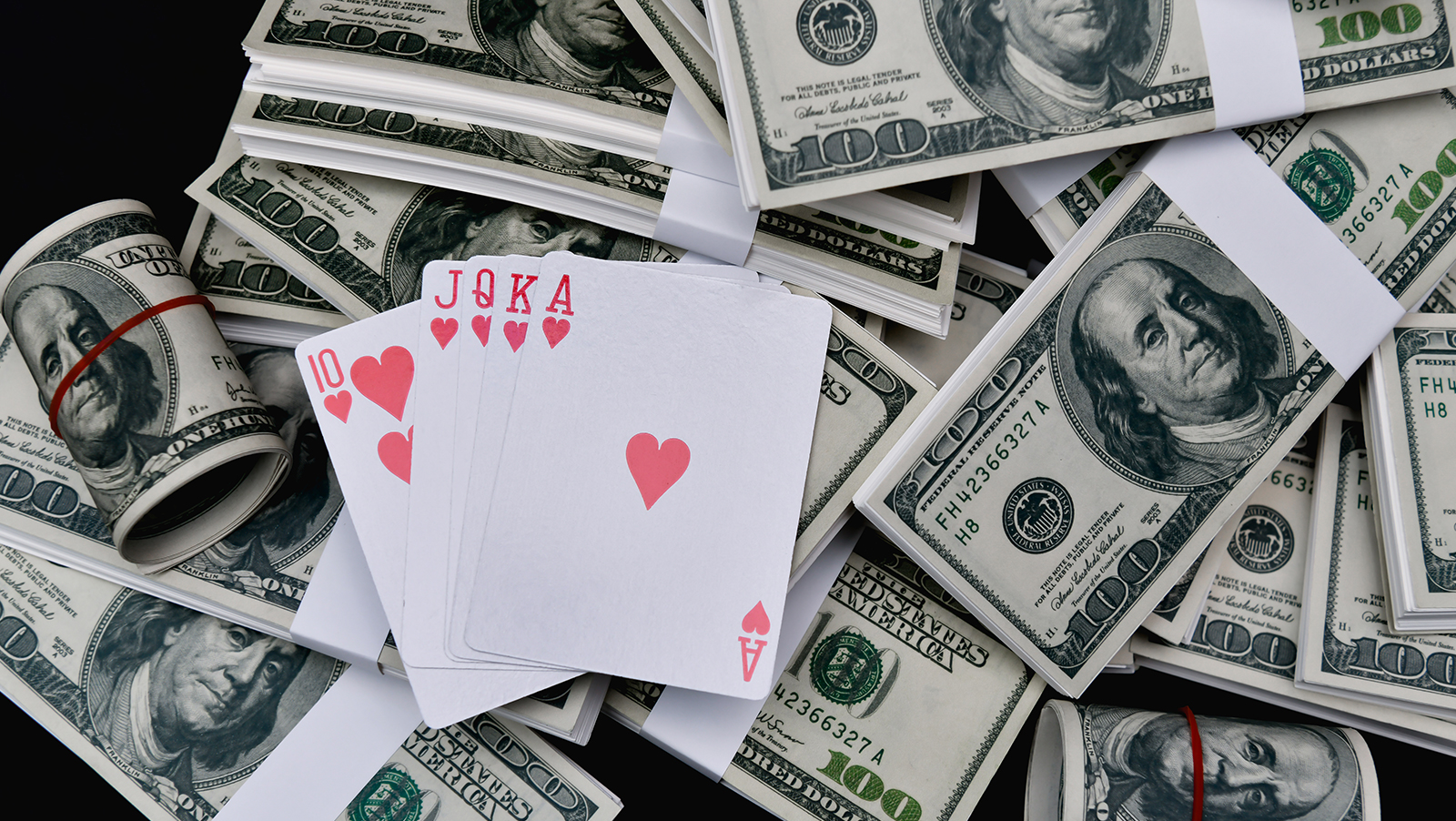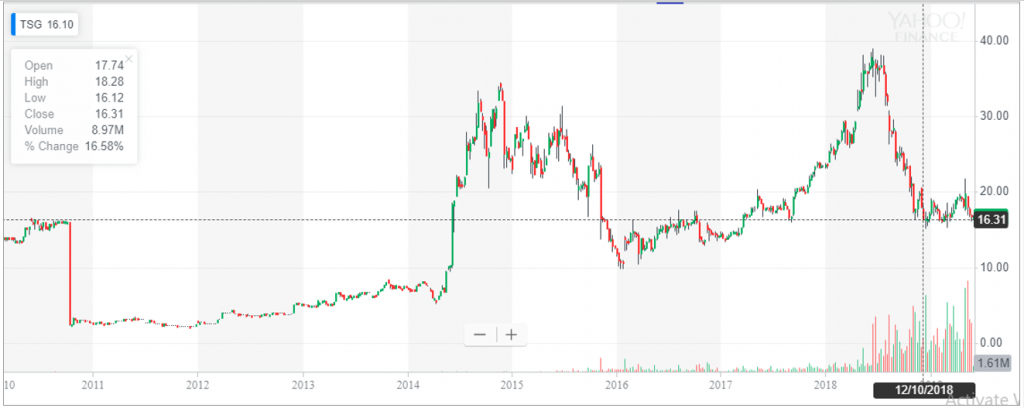If you invest like a poker player, The Stars Group is the perfect stock for you. Its price action makes little fundamental sense and resembles a follow-the-herd type of movement. Shares can go any which way and upper management keeps TSG’s hand close to its chest. It’s hard to tell exactly what cards TSG is holding.
 Bullish sentiment sets shares on fire, but then mood sours and a selling avalanche begins for little apparent reason. The bull run from 2016 – 2018 can be explained in the context of the broader recovery in global equities that coincided with the easing of pressure off the Macau VIPs. This got much of the gaming sector moving after the collapse of 2014 and the wider consolidation of 2015. But if you zoom in at TSG’s collapse from highs of $39 last year, there is no clear and obvious reason to explain it other than a change in sentiment.
Bullish sentiment sets shares on fire, but then mood sours and a selling avalanche begins for little apparent reason. The bull run from 2016 – 2018 can be explained in the context of the broader recovery in global equities that coincided with the easing of pressure off the Macau VIPs. This got much of the gaming sector moving after the collapse of 2014 and the wider consolidation of 2015. But if you zoom in at TSG’s collapse from highs of $39 last year, there is no clear and obvious reason to explain it other than a change in sentiment.
Last year’s fall in the US indexes began in late September, TSG’s three months beforehand. So its collapse can’t be explained by beta market conditions, or liquidation to raise cash in a broader bear market. Plus, TSG has not participated at all in the massive slingshot rally since late December (that appears to be cooling off now). Shares remain pretty much unchanged while the S&P 500 rocketed 25% higher.
Consider the circumstances of TSG’s collapse last summer. On August 13th, shares plummeted 16%, with analysts looking for post facto explanations that contradicted headlines put out the same day. On the one hand TSG beat revenue and earnings expectations. On the other hand, the market had “higher expectations”. Which one is it? The one thing you could point to that had something to do with TSG’s collapse since last year was dilution throughout the decline. A forced conversion of preferred shares to common shares and the elimination of the rights of preferred shareholders led to a 52.66:1 conversion ratio and the issuance of about 60 million common shares in early June. Another 20 million shares were issued in a public offering two weeks later. Even factoring this in, that the stock could not rally on the back of one of the most powerful short term rallies in the US stock market ever, is a worrying sign.
The good news for speculators though is that downside looks relatively limited, at least compared to what it was at last year’s highs of $39. Long term support is holding at around $10, which is still quite a ways down from where we are now at $16.66, but it’s a manageable risk for a small position. What is interesting is that from a technical perspective, the stock may be at an inflection point, and could go sharply either way.

Glance at this long term chart, which includes the Amaya era, and the level we are at now (horizontal line) has served as a major pivot point 6 times in the past. If support breaks at about $15, we could be headed to the $10 range, though at that point I would expect the stock to rebound sharply. The simplest thing to do would be to split, say, a 5% position into two tranches, buy half now in case of a rally, and buy the other half if and when support breaks below $15. If there is no breakdown, just keep the position at half. The options market is thin in this stock so doing a straddle is risky.
Fundamentally, the case for a rally isn’t that great. It’s conceivable because shares are erratic, but there’s nothing that stands out as an obvious reason to buy other than that shares are near lows. The business model looks a lot like GVC, wrought with inherent instabilities due to the opacity of its markets. CEO Rafi Ashkenazi blamed disrupted markets for falls in revenue, which is true, but the problem is TSG operates in dangerous grey markets and nobody outside of insiders really knows where they are. All we know is that there is an “international segment” that is a mashup of a bunch of jurisdictions that TSG doesn’t want to specify. So suddenly these unknown markets are disrupted and earnings take a hit.
There is a breakdown of geographic region by license (not customer location) which does sort of break down the regulated versus more dangerous markets. The annual report lists Isle of Man, Malta, Italy, the UK, Spain, Australia, and at the bottom, “Other licensed or approved jurisdictions”. OK, so where are those? Doesn’t say. All we know is that 15% of total revenues came from “Other” in 2018, up from 11.2% in 2017. According to Ashkenazi, these “Other” jurisdictions represented 21% of international business last quarter, and that figure is now down to 16%. The basic issue is that the fastest growth for TSG is coming from markets that are not fully disclosed in its filings, making the stock’s movements even harder to predict or understand.
Certainly, there are positives to mention, including great potential in the US market, but it will take several years for TSG to see any stable gains from this. The deal with FOX to launch FOX Bet is a strong long term positive, but it’s a stretch to say that this will lead to anything substantial in the bottom line over the next year or two. Keep in mind also that the deal with FOX required some dilution as well, as FOX got 14.35M new shares as part of the deal. That’s $236M in dilution on the backs of shareholders, about 5% of market cap. Brand popularity is obvious, record online and land-based poker tournaments etc., but brand recognition doesn’t mean money is consistently being made. If I asked you to name a car company off the top of your head and you say “Tesla” that signals Tesla has great brand recognition but at the cost of losing billions of dollars. I’m not comparing TSG to Tesla here, rather just making a point that a popular brand is a means to an end and not an end in itself.
Net debt is over 100% of market cap, high but no immediate problems as debt is hedged. Then there is the triple threat of a No Deal Brexit, which just became a bit more likely with Theresa May’s fall and would seriously affect its UK markets in the short term, the threat of a recession in the United States that is already in an inverted yield curve, and Trump firing wildly in all directions at anybody trading anything across international borders, threatening to spark and exacerbate any imminent decline.
If the global picture were a bit more stable, TSG could be a good speculative allocation here. Still, it’s not the worst choice at these levels, but there’s little way to discern which direction it’s headed in next. It’s a poker game. If you’re comfortable with that, go ahead and play a hand.